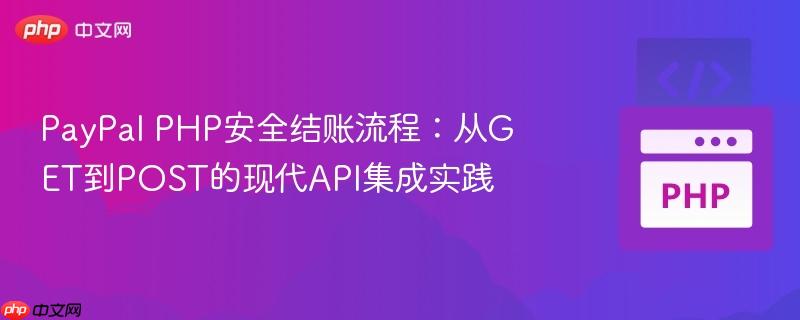
本文详细阐述了如何将不安全的get请求paypal结账方式迁移至安全、可靠的post方法。通过集成paypal的现代服务器端api和php sdk,教程涵盖了订单创建、订单捕获以及前端交互的核心流程,旨在防止数据篡改,确保支付过程的完整性和安全性。
在构建在线支付系统时,安全性是首要考虑的因素。传统的PayPal结账方式,特别是通过构建GET请求参数重定向用户到PayPal页面的做法,存在显著的安全隐患。这种方式允许恶意用户通过代理篡改URL参数,例如修改商品金额、数量甚至收款人邮箱,从而导致严重的经济损失和业务风险。为了规避这些问题,PayPal官方推荐使用其现代的服务器端API进行结账流程管理,实现一个基于POST请求且更安全的集成方案。
原始的GET请求方式通过http_build_query构建参数,然后重定向用户。虽然简单,但其本质是将所有交易细节暴露在URL中,极易被拦截和篡改。
<?php
// 不推荐的GET请求示例(仅为说明问题)
public function checkoutLegacyGet()
{
$query = [];
$query['cmd'] = '_cart';
$query['upload'] = 1;
$query['business'] = $this->getCredential(); // 收款人邮箱
// ... 其他商品及订单信息 ...
$query_string = http_build_query($query);
// 这种方式生成的URL可以直接被用户篡改
return "https://www.paypal.com/cgi-bin/webscr?" . $query_string;
}
?>这种方法将敏感信息(如商家邮箱、商品价格)作为URL参数传递,极易被中间人攻击或恶意用户修改。
PayPal推荐的现代结账流程采用服务器端API调用,结合前端JavaScript SDK实现用户友好的支付体验。核心思想是将敏感的订单创建和捕获逻辑放在服务器端处理,前端只负责触发支付流程和接收PayPal的响应。
立即学习“PHP免费学习笔记(深入)”;
此流程主要分为两个独立的服务器端路由:
首先,通过Composer安装PayPal的PHP Checkout SDK。这是进行服务器端API调用的官方推荐方式。
composer require paypal/paypal-checkout-sdk
在使用SDK之前,需要配置API客户端,包括您的Client ID和Client Secret,以及指定运行环境(沙盒或生产)。
<?php
use PayPalCheckoutSdk\Core\PayPalHttpClient;
use PayPalCheckoutSdk\Core\SandboxEnvironment;
use PayPalCheckoutSdk\Core\ProductionEnvironment;
class PayPalClient
{
/**
* Returns PayPal HTTP client instance with environment that has access
* credentials context. Use this to invoke PayPal APIs.
*/
public static function client()
{
return new PayPalHttpClient(self::environment());
}
/**
* Set up and return PayPal PHP SDK environment with PayPal access credentials.
* This is where you would use your client ID and client secret.
*/
public static function environment()
{
$clientId = getenv("PAYPAL_CLIENT_ID") ?: "YOUR_PAYPAL_CLIENT_ID";
$clientSecret = getenv("PAYPAL_CLIENT_SECRET") ?: "YOUR_PAYPAL_CLIENT_SECRET";
// 根据您的需求选择沙盒环境或生产环境
if (getenv("APP_ENV") === "production") {
return new ProductionEnvironment($clientId, $clientSecret);
} else {
return new SandboxEnvironment($clientId, $clientSecret);
}
}
}
?>这个路由负责向PayPal发起订单创建请求。它接收来自前端的商品信息,并在服务器端构建订单详情,然后调用PayPal API。
<?php
use PayPalCheckoutSdk\Orders\OrdersCreateRequest;
// 假设这是一个处理创建订单请求的控制器方法或路由处理函数
public function createOrderHandler(Request $request)
{
// 1. 从请求中获取商品信息 (通常是商品ID和数量,然后在服务器端查询价格,防止篡改)
$itemsData = $request->input('items'); // 示例:[['id' => 'prod1', 'quantity' => 2]]
$purchaseUnits = [];
$totalAmount = 0;
foreach ($itemsData as $item) {
// 在服务器端查询商品详情和价格,确保数据准确性
$product = $this->getProductDetails($item['id']); // 假设存在此方法
if (!$product) {
return response()->json(['error' => 'Product not found'], 400);
}
$itemAmount = $product->price * $item['quantity'];
$totalAmount += $itemAmount;
$purchaseUnits[] = [
'reference_id' => uniqid(), // 唯一引用ID
'amount' => [
'currency_code' => 'USD', // 货币代码
'value' => number_format($itemAmount, 2, '.', ''),
'breakdown' => [
'item_total' => [
'currency_code' => 'USD',
'value' => number_format($itemAmount, 2, '.', '')
]
]
],
'items' => [
[
'name' => $product->name,
'unit_amount' => [
'currency_code' => 'USD',
'value' => number_format($product->price, 2, '.', '')
],
'quantity' => $item['quantity']
]
]
];
}
$request = new OrdersCreateRequest();
$request->prefer('return=representation');
$request->body = [
"intent" => "CAPTURE", // 意图:捕获
"application_context" => [
"return_url" => "https://yourdomain.com/paypal-success", // 支付成功后重定向URL
"cancel_url" => "https://yourdomain.com/paypal-cancel", // 支付取消后重定向URL
"brand_name" => "Your Store Name",
"locale" => "en-US",
"landing_page" => "BILLING",
"shipping_preference" => "NO_SHIPPING" // 根据需求设置
],
"purchase_units" => $purchaseUnits,
"payer" => [
// 可选:如果已知用户邮箱等信息,可在此处预填
// 'email_address' => 'customer@example.com'
]
];
try {
$client = PayPalClient::client();
$response = $client->execute($request);
// 返回订单ID和批准链接给前端
return response()->json([
'id' => $response->result->id,
'status' => $response->result->status,
'links' => $response->result->links
]);
} catch (Exception $ex) {
// 错误处理
return response()->json(['error' => $ex->getMessage()], 500);
}
}
?>注意事项:
用户在PayPal界面完成授权后,前端会将PayPal返回的订单ID发送到此路由。此路由负责调用PayPal API执行实际的支付捕获操作。
<?php
use PayPalCheckoutSdk\Orders\OrdersCaptureRequest;
// 假设这是一个处理捕获订单请求的控制器方法或路由处理函数
public function captureOrderHandler(Request $request)
{
$orderId = $request->input('orderID'); // 从前端获取的订单ID
$request = new OrdersCaptureRequest($orderId);
$request->prefer('return=representation');
try {
$client = PayPalClient::client();
$response = $client->execute($request);
// 2. 处理捕获结果
if ($response->result->status === 'COMPLETED') {
// 支付成功
$transactionId = $response->result->purchase_units[0]->payments->captures[0]->id;
// 3. 存储支付详情到数据库
// 例如:$this->orderService->updateOrderStatus($orderId, 'paid', $transactionId);
// 务必存储 PayPal 交易ID (transactionId),用于后续对账和查询。
// 示例:$order->paypal_transaction_id = $transactionId; $order->save();
// 4. 执行业务逻辑 (例如:发送订单确认邮件、减少库存、生成发货单等)
// $this->sendOrderConfirmationEmail($orderId);
// $this->updateProductInventory($orderId);
return response()->json([
'status' => 'success',
'order_id' => $orderId,
'transaction_id' => $transactionId,
'details' => $response->result
]);
} else {
// 支付状态不是COMPLETED,可能需要进一步处理(例如:PENDING, DENIED等)
return response()->json([
'status' => 'failed',
'message' => 'Payment not completed',
'details' => $response->result
], 400);
}
} catch (Exception $ex) {
// 错误处理
return response()->json(['error' => $ex->getMessage()], 500);
}
}
?>注意事项:
前端负责渲染PayPal支付按钮,并在用户点击并完成PayPal授权后,将结果(特别是订单ID)传递给您的服务器端捕获订单路由。
<!-- 在您的HTML页面中引入PayPal JavaScript SDK -->
<script src="https://www.paypal.com/sdk/js?client-id=YOUR_PAYPAL_CLIENT_ID¤cy=USD"></script>
<div id="paypal-button-container"></div>
<script>
paypal.Buttons({
createOrder: function(data, actions) {
// 调用您的服务器端创建订单API
return fetch('/api/paypal/create-order', {
method: 'post',
headers: {
'content-type': 'application/json'
},
body: JSON.stringify({
items: [ // 示例:传递商品信息给后端
{ id: 'prod1', quantity: 1 },
{ id: 'prod2', quantity: 2 }
]
})
}).then(function(res) {
return res.json();
}).then(function(orderData) {
// 返回PayPal订单ID
return orderData.id;
});
},
onApprove: function(data, actions) {
// 用户在PayPal完成授权后,调用您的服务器端捕获订单API
return fetch('/api/paypal/capture-order', {
method: 'post',
headers: {
'content-type': 'application/json'
},
body: JSON.stringify({
orderID: data.orderID // PayPal返回的订单ID
})
}).then(function(res) {
return res.json();
}).then(function(orderData) {
// 处理支付结果
if (orderData.status === 'success') {
alert('支付成功!交易ID: ' + orderData.transaction_id);
window.location.href = '/order-confirmation/' + orderData.order_id;
} else {
alert('支付失败:' + orderData.message);
window.location.href = '/payment-failed';
}
});
},
onCancel: function (data) {
// 用户取消支付
alert('支付已取消!');
window.location.href = '/payment-cancelled';
},
onError: function (err) {
// 支付过程中发生错误
console.error('PayPal支付错误:', err);
alert('支付过程中发生错误,请稍后重试。');
window.location.href = '/payment-error';
}
}).render('#paypal-button-container'); // 渲染PayPal按钮
</script>注意事项:
通过将PayPal结账流程从GET请求迁移到服务器端POST API调用,您可以显著提升支付系统的安全性、可靠性和可维护性。
关键要点:
遵循这些指导原则,您将能够构建一个安全、高效且符合PayPal最佳实践的PHP支付集成方案。
以上就是PayPal PHP安全结账流程:从GET到POST的现代API集成实践的详细内容,更多请关注php中文网其它相关文章!

PHP怎么学习?PHP怎么入门?PHP在哪学?PHP怎么学才快?不用担心,这里为大家提供了PHP速学教程(入门到精通),有需要的小伙伴保存下载就能学习啦!

Copyright 2014-2025 https://www.php.cn/ All Rights Reserved | php.cn | 湘ICP备2023035733号